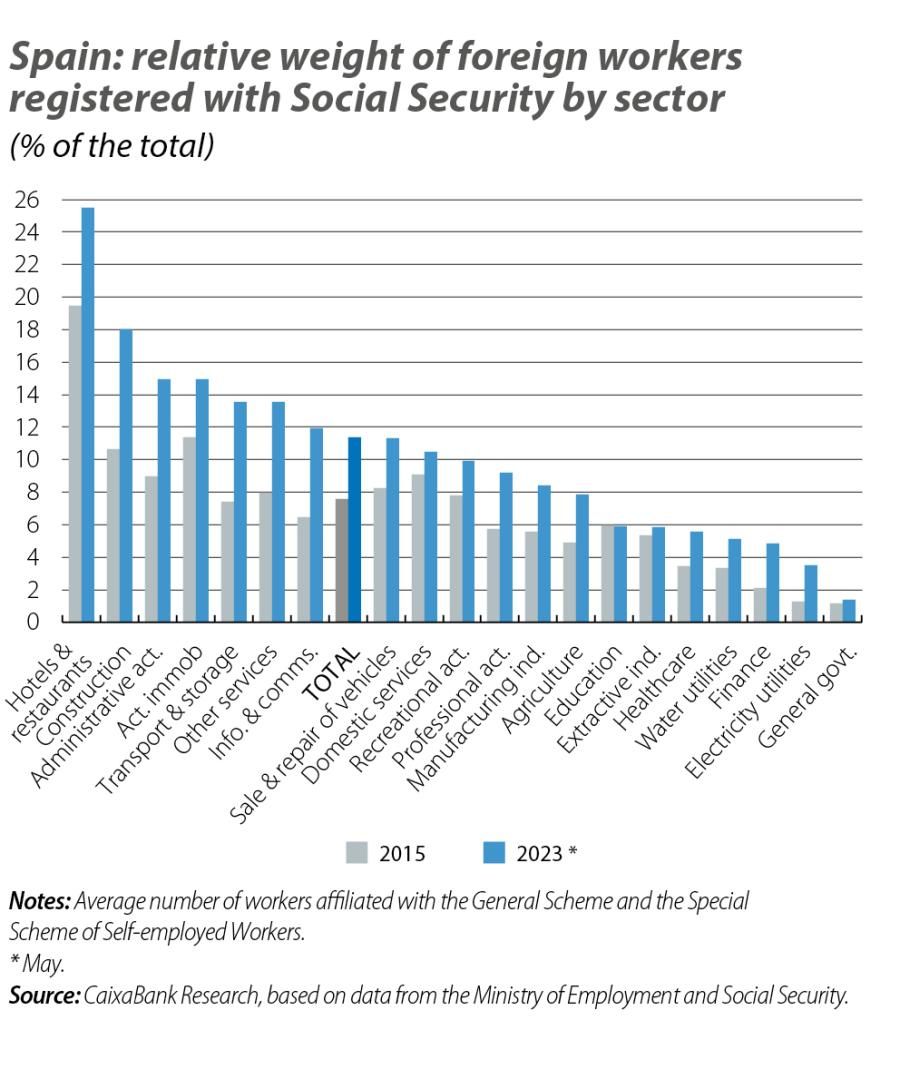The changing composition of the immigrant population in recent years
Immigration plays an essential role in ensuring the sustainability of demographics and employment in an ageing society with a very low birth rate like that of Spain. In this article we analyse the recent evolution of immigration flows into Spain, their geographical distribution and their socio-economic characteristics.

The demographic dynamics of the Spanish population, in particular the inexorable ageing process and a very low birth rate, are leading to negative natural growth. Hence the vital importance of migratory flows for ensuring demographic sustainability and the level of employment: since the mid-1990s, the foreign population has been an increasingly important group, and this has helped with increasing and rejuvenating the total population and labour force.1 According to the latest data from the LFS (Q1 2023), foreigners accounted for 12.1% of the total population (5.74 million) and 13.3% of all employment (over 2.7 million workers), compared to the 9.2% and 10.8%, respectively, which they represented in 2015.2 In this article, we analyse the evolution of immigration flows in recent years, as well as possible changes in their geographical distribution and some of their socio-economic characteristics.
Evolution of the population in Spain from 2015 to the present
In mid-2015, the total population began to rise – a trend that was interrupted during the pandemic,3 but which resumed in mid-2021. Since then, the rate of annual population growth has accelerated to 1.0% in Q1 2023 – a rate not seen since before the 2008 financial crisis. In all, the cumulative population growth since Q3 2015 comes to around 1.4 million people (+3.0%). This increase has been made possible by the growth of the foreign population, which is up by more than 1.5 million,4 as well as those with dual nationality, up by 600,000. The population with only Spanish nationality, in contrast, has fallen by 709,200.
- 3Q1 2021 saw the biggest fall in the Spanish population series (–333,200 people), essentially due to the decrease in the number of births (the population under 15 years of age dropped by 294,000) and, to a lesser extent, to higher mortality among the older age groups, where COVID-19 had a greater impact.
- 4The majority come from Latin America (921,000) and just 37,000 are citizens of EU countries.

Geographical distribution of immigration in Spain
By region, the increase in the foreign population has been widespread, although four regions (Madrid, Catalonia, Valencia and Andalusia) stand out and account for two thirds of this total increase (almost a million more foreigners since Q3 2015). In these regions, except in Andalusia, the national population has also increased, making them the regions with the biggest total population growth in absolute terms (in relative terms, the Balearic Islands stand out, with an increase of 10.1%, followed by Madrid, the Canary Islands and Murcia). Thus, the foreign population has increased as a proportion of the total in all regions, especially in the archipelagos and Navarre (between 4 and 5 points); at the opposite end of the spectrum we find Murcia and Extremadura, where the growth has been below 2 points. Whereas in the Balearic Islands almost 24% of the population is foreign, the portion of foreigners in Extremadura is 20 points lower.


Distribution of immigration in Spain by age
As for the distribution by age group, the growth of the total population since Q3 2015 has been concentrated in the older age groups, from 45 years and up (almost 2.9 million more), especially Spaniards (1.69 million) as a result of the ageing of the baby boomers. In contrast, there is a sharp fall in the population from 25 to 44 years of age (–1.62 million), where the increase in foreigners has been insufficient to offset the sharp decline in nationals (of more than two million). In general, the foreign population has increased in all age groups, but especially in the over-45 group (881,000). This pattern is partly driven by the high migratory flows that arrived in the early 2000s and reflects the fact that the ageing of the population is also affecting foreigners, albeit to a lesser degree than in the case of nationals.

As a result of all this, there has been an increase in the relative weight of the foreign population in all age groups in recent years, especially in the youngest category (under 15 years) and in the 45 to 54 age group (13.4% vs. 8.7%). In the case of the former, foreigners account for 11.9% of all those under 15 years of age, which is 5 points more than in Q3 2015, reflecting both the younger age of the individuals arriving in our country and their higher birth rate. In the group aged 25 to 44, the growth has been somewhat lower, but foreigners now represent around 20% of the total. On the other hand, those over 55 years of age accounted for 6.3% of the population (4.0% in Q3 2015).

Immigration and employment
As far as the education level of foreigners is concerned, it is actually higher than is often believed. While it is true that the least educated individuals (with incomplete primary studies or no studies) make up a larger portion of the foreign population than among Spaniards (7.3% of those over 16 years of age vs. 5.1%) and those with higher education are proportionally fewer (23.7% vs. 34.1%), foreigners with secondary education make up the group that has grown the most in recent years: since Q3 2015 their numbers have increased by 751,000 (+35.9% vs. 3.9% for Spaniards) to represent 58.1% of the total, exceeding the figure of 2015 (56.8%) as well as that corresponding to Spanish citizens (49.7%).
As for the jobs performed by foreigners, in recent years we have seen a widespread increase in the relative weight of these workers across the board, although their presence is greater in elementary occupations and jobs with lower skills requirements. For example, in terms of Social Security affiliates, more than 25% of those employed in the hotel and restaurant industry and 18% in construction are foreigners, whereas in 2015 these percentages stood at 19.5% and 10.6%, respectively; in transport and storage there has also been a significant increase, going from 7.4% to 13.6%. At the other end of the scale, the role of foreigners is less relevant in the industrial branches of the economy, including extractive industries (5.9% vs. 5.3%) and manufacturing (8.4% vs. 5.6%).
The fact that the presence of foreign workers is greater at low qualification levels may indicate a certain over-qualification. This phenomenon, while not exclusive to foreign workers, is somewhat more pronounced among this group compared to Spaniards: on the one hand, the presence of foreign workers with higher education in elementary occupations is almost seven times higher (12% vs. 1.8% for Spaniards);5 on the other hand, a study by the National Statistics Institute6 reveals that more than half of foreign workers (51.1%) – a percentage which rises to 57.5% in the case of Latin American citizens and is reduced to 46.9% for Spaniards – considers that they could perform more skilled tasks given their level of education, experience or training.
- 5See Ministry of Inclusion, Social Security and Immigration (2022). «Informe sobre la integración de la población extranjera en el mercado laboral español» (content available in Spanish).
- 6See National Statistics Institute (2015). Labour Force Survey. Module on the employment situation of immigrants, 2014.

In the coming years, the ageing of the population will continue to determine the evolution of the labour supply; moreover, this process will accelerate in Spain and will be more intense than in the rest of the EU: the latest demographic projections by the National Statistics Institute suggest that the dependency ratio (the population aged 65 and above relative to the population aged between 16 and 64 years) will increase from 31% in 2021 to around 54% by 2050. In this situation with a reduced labour supply, migratory flows will play an essential role in maintaining the workforce. The National Statistics Institute itself forecasts that in the period 2030-2050 net annual inflows will be around 250,000 people (compared to less than 150,000 in 2021).